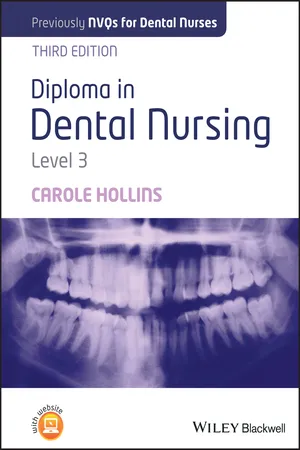
- English
- ePUB (mobile friendly)
- Available on iOS & Android
Diploma in Dental Nursing, Level 3
About this book
Diploma in Dental Nursing, Level 3 is the new edition of the must-have study companion for trainee dental nurses preparing for the City & Guilds Level 3 Diploma in Dental Nursing (formerly NVQ). The book offers comprehensive support on the units assessed by portfolio - from first aid and health and safety to specific chairside support procedures - as well as the four areas of the course tested by multiple choice questions: infection control, oral health assessment, dental radiography and oral health management.
This third edition of an established revision text has been substantially revised and restructured in line with the new qualification and reflects changes in the regulations and legislature affecting dentistry and dental workplaces, all of which have an effect on the daily role and working life of the dental nurse. It will be an invaluable guide for dental nurse trainees, qualified dental nurses and course providers.
- Expanded and revised, with extensive coverage of the fifteen Diploma units
- In full colour throughout with over 400 illustrations
- Companion website with downloadable glossary and MCQs for revision and self-assessment
Frequently asked questions
- Essential is ideal for learners and professionals who enjoy exploring a wide range of subjects. Access the Essential Library with 800,000+ trusted titles and best-sellers across business, personal growth, and the humanities. Includes unlimited reading time and Standard Read Aloud voice.
- Complete: Perfect for advanced learners and researchers needing full, unrestricted access. Unlock 1.4M+ books across hundreds of subjects, including academic and specialized titles. The Complete Plan also includes advanced features like Premium Read Aloud and Research Assistant.
Please note we cannot support devices running on iOS 13 and Android 7 or earlier. Learn more about using the app.
Information
1
Unit 301: Ensure Your Own Actions Reduce Risks to Health and Safety
Learning outcomes
- Be able to identify the hazards in the workplace
- Be able to act upon hazards in the workplace
- Be able to reduce the risks to health and safety in the workplace
Outcome 1 assessment criteria
- Identify which workplace procedures are relevant to their job
- Identify those working practices in the job that could harm them or others
- Identify those aspects of the workplace that could harm them or others
- Outline any differences between workplace legislation and supplier’s or manufacturer’s instructions
Outcome 2 assessment criteria
- Report hazards to the identified responsible person
- Demonstrate the ability to deal with hazards in the workplace
Outcome 3 assessment criteria
- Carry out their work in accordance with workplace legislation or manufacturer’s instructions
- Behave in a way that does not endanger their health and safety or that of others, or of the materials in the workplace
- Contribute to health and safety improvements within the workplace
- Follow guidelines for environmentally friendly working practices
- Ensure personal presentation protects their health and safety and that of others in line with instructions
- Observation in the workplace, with examples included in the learner’s portfolio
- An appropriate alternative method
- Use of some occupational equipment and items
- Use of some hazardous occupational substances
- Moving and handling of heavy items or hazardous substances
- Disposal of hazardous substances
Overview of responsibilities
Employers’ responsibilities
Table of contents
- Cover
- Title page
- Copyright page
- Introduction to the Third Edition
- Acknowledgements
- 1 Unit 301
- 2 Unit 302
- 3 Unit 268
- 4 Unit 304
- 5 Unit 305
- 6 Unit 306
- 7 Unit 307
- 8 Unit 308
- 9 Unit 309
- 10 Unit 310
- 11 Unit 311
- 12 Unit 312
- 13 Unit 313
- 14 Unit 314
- 15 Unit 315
- Index
- Access the Companion Website
- End User License Agreement